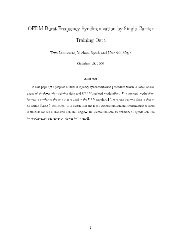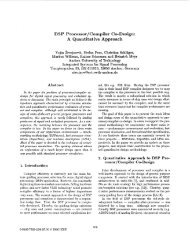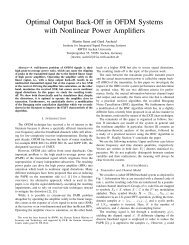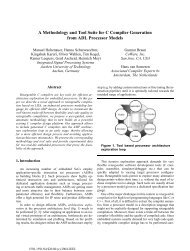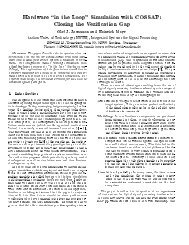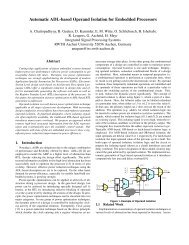Automatic Generation of JTAG Interface and Debug Mechanism - ICE
Automatic Generation of JTAG Interface and Debug Mechanism - ICE
Automatic Generation of JTAG Interface and Debug Mechanism - ICE
Create successful ePaper yourself
Turn your PDF publications into a flip-book with our unique Google optimized e-Paper software.
(e.g. for the state machine for division instructions). Thus,<br />
data breakpoints related to these registers are not required.<br />
Consequently, in a third synthesis (table 1, run 3), we only<br />
added breakpoints <strong>and</strong> debug access to the five main registers.<br />
With this reasonably reduced amount <strong>of</strong> debug capabilities<br />
the required chip area for the complete architecture takes<br />
36.4 kGates. This is only an increase <strong>of</strong> 15 % compared to<br />
the area used for the architecture without debug interface. The<br />
slight decrease <strong>of</strong> area consumption for the pipeline results<br />
from dynamic optimization criteria <strong>of</strong> the synthesis tool <strong>and</strong><br />
range within its accuracy.<br />
area (kGates)<br />
run 1 run 2 run 3<br />
architecture no debug full debug reduced debug<br />
part capabilities capabilities capabilities<br />
total 31.6 100% 45.6 144% 36.4 115%<br />
pipeline 20.4 100% 20.4 100% 19.7 97%<br />
register file 11.1 100% 15.9 143% 12.1 109%<br />
debug SM - 7.7 3.1<br />
mode control - 0.2 0.2<br />
test-data-reg - 0.6 0.6<br />
TAP controller - 0.6 0.6<br />
Table 1. Area Consumption for Three Configurations<br />
<strong>of</strong> the M68HC11<br />
The implementation has been chosen in such a way that,<br />
potential critical paths are least affected. However, as can be<br />
seen in section 5 the debug-write features could not be fully<br />
removed from this critical path. Thus, there is a theoretical<br />
influence on the timing. Nevertheless, for this case study the<br />
deviations concerning timing range within the accuracy <strong>of</strong> the<br />
gate level synthesis tool. The data arrival time <strong>of</strong> the critical<br />
path amounted to about 4.5 ns. Thus, the values <strong>of</strong> the resulting<br />
maximum frequencies all are located in the range from 215<br />
MHz to 225 MHz.<br />
7 Conclusion <strong>and</strong> Future Work<br />
In this paper we presented the first automatic generation<br />
<strong>of</strong> a <strong>JTAG</strong> interface <strong>and</strong> debug mechanism from an ADL. This<br />
generation is embedded into our RTL processor synthesis flow,<br />
which uses the language LISA to generate an RTL representation<br />
<strong>of</strong> the architecture. The <strong>JTAG</strong> interface is used as interface<br />
to the architecture <strong>and</strong> thus to the debug mechanism.<br />
The debug mechanism enables features like program <strong>and</strong> data<br />
breakpoints or register read <strong>and</strong> write access. The presented<br />
synthesis results clarified that debugging capabilities should<br />
be chosen judiciously, as they have a major effect on the chip<br />
area <strong>of</strong> the target architecture. Using our RTL processor synthesis<br />
tool, the designer is able to perform this selection during<br />
design space exploration.<br />
In our future work we will investigate the suitability <strong>of</strong> our<br />
debug mechanism for architectures <strong>of</strong> various domains. Moreover,<br />
the results showed, that the current breakpoint implementation<br />
has a major impact on the required area consumption.<br />
Different improvements to the current implementation <strong>of</strong><br />
breakpoints are being investigated. Their implementation will<br />
be addressed in our future work.<br />
References<br />
[1] G. Hadjiyiannis <strong>and</strong> S. Devadas. Techniques for Accurate Performance<br />
Evaluation in Architecture Exploration. IEEE Transactions on VLSI<br />
Systems, 2002.<br />
[2] P. Mishra, A. Kejariwal, <strong>and</strong> N. Dutt. Rapid Exploration <strong>of</strong> Pipelined<br />
Processors through <strong>Automatic</strong> <strong>Generation</strong> <strong>of</strong> Synthesizable RTL Models<br />
Rapid System Prototyping. Workshop on Rapid System Prototyping<br />
(RSP), 2003.<br />
[3] V. Rajesh <strong>and</strong> R. Moona. Processor Modeling for Hardware S<strong>of</strong>tware<br />
Codesign. In Int. Conf. on VLSI Design, Jan. 1999.<br />
[4] O. Schliebusch, A. H<strong>of</strong>fmann, A. Nohl, G. Braun, <strong>and</strong> H. Meyr. Architecture<br />
Implementation Using the Machine Description Language LISA.<br />
In Proc. <strong>of</strong> the ASPDAC/VLSI Design - Bangalore, India, Jan. 2002.<br />
[5] Schliebusch, O. <strong>and</strong> Chattopadhyay, A. <strong>and</strong> Steinert, M. <strong>and</strong> Braun, G.<br />
<strong>and</strong> Nohl, A. <strong>and</strong> Leupers, R. <strong>and</strong> Ascheid, G. <strong>and</strong> Meyr, H. RTL Processor<br />
Synthesis for Architecture Exploration <strong>and</strong> Implementation. In<br />
Proceedings <strong>of</strong> the Conference on Design, Automation & Test in Europe<br />
(DATE) - Designers Forum, Paris, France, Feb 2004.<br />
[6] A. H<strong>of</strong>fmann, H. Meyr, <strong>and</strong> R. Leupers. Architecture Exploration for<br />
Embedded Processors with LISA. Kluwer Academic Publishers, 2002.<br />
[7] M. Steinert, O. Schliebusch, <strong>and</strong> O. Zerres. Design Flow for Processor<br />
Development using SystemC. In SNUG Europe Proceedings - Munich,<br />
Germany, Mar. 2003.<br />
[8] H. Scharwaechter, D. Kammler, A. Wieferink, M. Hohenauer, J. Zeng,<br />
K. Karuri, R. Leupers, G. Ascheid, <strong>and</strong> H. Meyr. ASIP Architecture<br />
Exploration for Efficient IPSec Encryption: A Case Study. In Proc.<br />
<strong>of</strong> the Workshop on S<strong>of</strong>tware <strong>and</strong> Compilers for Embedded Systems<br />
(SCOPES), Sep. 2004.<br />
[9] G. Hadjiyiannis <strong>and</strong> S. Hanono <strong>and</strong> S. Devadas. ISDL: An Instruction<br />
Set Description Language for Retargetability. In Proc. <strong>of</strong> the Design<br />
Automation Conference (DAC), Jun. 1997.<br />
[10] A. Fauth <strong>and</strong> J. Van Praet <strong>and</strong> M. Freericks. Describing Instruction<br />
Set Processors Using nML. In Proc. <strong>of</strong> the European Design <strong>and</strong> Test<br />
Conference (ED&TC), Mar. 1995.<br />
[11] Target Compiler Technologies. http://www.retarget.com.<br />
[12] A. Halambi <strong>and</strong> P. Grun <strong>and</strong> V. Ganesh <strong>and</strong> A. Khare <strong>and</strong> N. Dutt <strong>and</strong><br />
A. Nicolau. EXPRESSION: A Language for Architecture Exploration<br />
through Compiler/Simulator Retargetability. In Proc. <strong>of</strong> the Conference<br />
on Design, Automation & Test in Europe (DATE), Mar. 1999.<br />
[13] P. Paulin <strong>and</strong> C. Liem <strong>and</strong> T.C. May <strong>and</strong> S. Sutarwala. FlexWare: A<br />
Flexible Firmware Development Environment for Embedded Systems.<br />
In P. Marwedel <strong>and</strong> G. Goosens, editors, Code <strong>Generation</strong> for Embedded<br />
Processors. Kluwer Academic Publishers, 1995.<br />
[14] A. Kitajima <strong>and</strong> M. Itoh <strong>and</strong> J. Sato <strong>and</strong> A. Shiomi <strong>and</strong> Y. Takeuchi <strong>and</strong><br />
M. Imai. Effectiveness <strong>of</strong> the ASIP Design System PEAS-III in Design<br />
<strong>of</strong> Pipelined Processors. In Proc. <strong>of</strong> the Asia South Pacific Design<br />
Automation Conference (ASPDAC), Jan. 2001.<br />
[15] ASIP Meister. http://www.eda-meister.org.<br />
[16] R. Gonzales. Xtensa: A configurable <strong>and</strong> extensible processor. IEEE<br />
Micro, Mar. 2000.<br />
[17] Tensilica. http://www.tensilica.com.<br />
[18] Stretch. http://www.stretchinc.com.<br />
[19] V. Kathail <strong>and</strong> S. Aditya <strong>and</strong> R. Schreiber <strong>and</strong> B.R. Rau <strong>and</strong> D. Cronquist<br />
<strong>and</strong> M. Sivaraman. <strong>Automatic</strong>ally Designing Custom Computers.<br />
IEEE Computer, 35(9):39–47, Sept. 2002.<br />
[20] IEEE-ISTO. The Nexus 5001 Forum, St<strong>and</strong>ard for a Global Embedded<br />
Processor <strong>Debug</strong> <strong>Interface</strong>, December 1999.<br />
[21] IEEE, Inc., 3 Park Avenue, New York, NY 10016-5997, USA. IEEE Std<br />
1149.1-2001, St<strong>and</strong>ard Test Access Port <strong>and</strong> Boundary-Scan Architecture,<br />
June 2001.<br />
[22] Synopsys. DesignWare Components<br />
http://www.synopsys.com/products/designware/designware.html.<br />
[23] Motorola. 68HC11: Microcontroller<br />
http://www.motorola.com.




